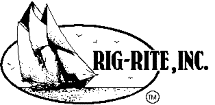 |
Spars, Rigging, and Hardware for SailboatsRig-Rite, Inc. |
 |
Spars, Rigging, and Hardware for SailboatsRig-Rite, Inc. |
IntroductionThe Hyde Streamstay One was the first modern furling system. Designed by Tim Stearn and introduced in 1971, it is still in use on thousands of yachts worldwide. The popularity of the Hyde system was largely due to the large charter boat operations, who embraced it early on for its bulletproof nature, easy maintenance attributes, and its unmatched reliability. Occasional bearing replacement (on average about 8 years), and periodic inspection are all that is necessary to keep this system in top form indefinitely. Although new systems are still being made, we frequently get calls from people who bought a used one or who found a system abandoned in a boatyard. Usually all these systems need is a bearing replacement kit or a shortening kit to put them back in use on a new yacht – which they will probably out-last as well. ~ Top ~ |
Features
~ Top ~ |
|
|
System SpecificationsThe Hyde Streamstay One is a furling system with a round, aluminum, one-piece, solid Rod luff extrusion, that replaces the conventional wire forestay. It may have one or two luff grooves. System Sizes are identified by Rod Diameter. If you are looking for replacement parts, you must know your System Size!* |
| * Measure diameter "D" carefully – sizes vary by as little as 1/16" |  |
* Additional sizes: 3 13/16", 4 5/16", 5", & 7 5/8"
available.
~ Top ~ |
||||||||||||||||||||||||||||||||||||||||||||||||||||||||||||||||||||||||||||||||||||||||||||||||||||||||||||||||||||||||||||||||||||||||||||||||||||
Parts Breakdown
|
||||||||||||||||||||||||||||||||||||||||||||||||||||||||||
Part # |
|
| 28 -- Top Deck Eye (specify Pin diameter) | Hyde # * -28 |
| 27 -- Drive Lock Pins (2 per end) | Hyde # * -27 |
| 26 -- Top Barrel Housing | Hyde # * -26 |
| 25 -- Compression Sleeve | Hyde # * -25 |
| 24 -- Dowel Pins (1 or 2 per end) | Hyde # * -24� |
| 23 -- Luff Rod | Hyde # * -23� |
| 22 -- Halyard Swivel Cover Screws (8 or 12) | Hyde # * -22 |
| 21 -- Halyard Swivel Top Cover Plate | Hyde # * -21 |
| 20 -- Snap Ring | Hyde # * -20 |
| 19 -- Halyard Swivel Core | Hyde # * -19 |
| 17 -- Halyard Swivel Bushings - Delrin (2) | Hyde # * -17� |
| 16 -- Halyard Swivel Bottom Cover Plate | Hyde # * -16 |
| 15 -- Halyard Swivel Assembly (parts 12-22) | Hyde # * -15A |
| 14 -- Halyard Swivel Bearings (2) | Hyde # * -14 |
| 13 -- Halyard Swivel Body | Hyde # * -13 |
| 12 -- Tack or Head Fastpin (2) | Hyde # * -12 |
| 11 -- Drum Cover Screw (2 or 4) | Hyde # * -11 |
| 10 -- Drum Screw (4 or 6) | Hyde # * -10 |
| 9 -- Furling Drum (specify diameter) | Hyde # * -9 |
| 8 -- Furling Drum Cover (specify diameter) | Hyde # * -8 |
| 7 -- Tapered Terminal End | Hyde # * -7 |
| 6 -- High-torque Lock Nut | Hyde # * -6 |
| 5 -- Barrel End Set-screw (2 per end) | Hyde # * -5 |
| 4 -- Barrel House Bearing | Hyde # * -4 |
| 3 -- Bottom Barrel Housing | Hyde # * -3 |
| 2 -- Oil Seal | Hyde # * -2 |
| 1 -- Bottom Deck Eye (specify Pin diameter) | Hyde # * -1 |
| * Substitute
System Size for *. 1 For Double Groove system, add -D to part #. 2 Specify split or whole. For #12 and #16 systems also specify bushing OD (1 1/4" or 1 1/2"). Note: For complete Part Numbers, additional Data, and Pricing, See Hyde System Pricing. |
|
~ Top ~
Bearing Replacement KitsWith a little easy maintenance and occasional Bearing Replacement, your Hyde System
should last several lifetimes. Bearings are easily replaced by any individual who is
mechanically inclined and has the ability to follow instructions. The system must be
down in order to do any bearing replacement. Bearing Replacement Kits are available in three configurations:
~ Top ~ |
||||||||||||
Shortening KitsShortening Kits are used to reduce overall system length, when modifying the rig or transferring the system to another boat. It is the upper end that is usually shortened so as not to change the height of the sail feed entrance.
~ Top ~ |
||||||
Replacement Halyard Swivel
~ Top ~ |
||||
AccessoriesHeavy Duty Jaw/Jaw Toggle Wire/Rope Furling Line
~ Top ~ |
TroubleshootingThe standard considerations in all furling system installations are:
If you are experiencing trouble with your Hyde System that is not related to any of those items above, it is usually one of the following problems:
~ Top ~ |
Ordering/Pricing
To place an Order, See Ordering, you will need Part Numbers. Complete Systems Pricing – Specify size, system length, pin diameters, and shipping destination and contact us for a quote. As these systems must be shipped full length, and shipping options are limited, please allow extra time for shipping arrangements and delivery. ~ Top ~ |